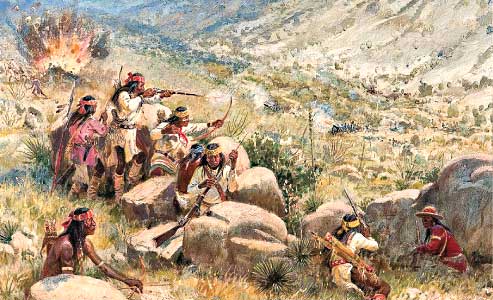
Chasing a stagecoach was mostly the stuff of Hollywood because it added more drama to the event. A well-conditioned horse could run, at most two to three miles.
A critic in reference to his 1949 film Stagecoach suggested to legendary director John Ford that lasted a greater part of the film that in real life the Apache would have killed the lead horses and the chase would have been over. Ford bluntly replied, “And so would my movie!”
In reality, the stage robbers, Indian, Mexican, or white tried to find a convenient, secluded place to pull a robbery. A hill or long slope was preferred. They also wanted a place of concealment to set up the ambush. Sometimes they would fire a warning shot to halt the stage and occasionally, they would shoot the shotgun messenger. For Mexicans and whites the charges would change from robbery to the much more serious charge of murder.
The Indians might pursue a stage on an open plain but that was unlikely. They’d usually set up an ambush in a pass.
The following is an account of an actual attack on a stagecoach in Arizona’s Apache Pass. The eastbound stage from Tucson with eleven people on board was making its way through the west end of the pass. As the coach rambled down a steep grade several shots rang out. Two men were hit as were the two lead mules. The mules were cut loose and the coach raced desperately for the station. At the bottom of a hill approaching the station was a small wooden bridge. Chiricahua warriors waited at the west entrance to pass for the eastbound Butterfield Stage from Tucson, bound for Lordsburg with eleven people on board. As the coach rumbled down a steep grade several shots rang out hitting two passengers and two lead two mules. The mules were quickly cut loose, and the coach raced desperately towards the station. At the bottom of the hill was a small wooden bridge. Prior to the ambush the clever Apache had removed the side planks over which the wheels would run in hopes of wrecking the stage. The driver put the whip to the remaining mules, who probably need no motivation. Traveling at a great speed, the coach bellied right across. The Apache gave up the chase and the stage limped safely into the station yard.
Next, they tried a similar plan to stop the westbound stage coming from Lordsburg on the east end of the pass. It was a commonly used method for stopping small wagon trains. They piled dried grass at both ends of a narrow passage and when the stages or wagons were far enough into the pass they would set fires at both ends trapping their prey between two fires. This time the ploy didn’t work as the Apache responsible for lighting the fire at the other end was negligent in his duty and forgot to light it, allowing the stage to plow right through the unlit grass and reach the station unmolested.





